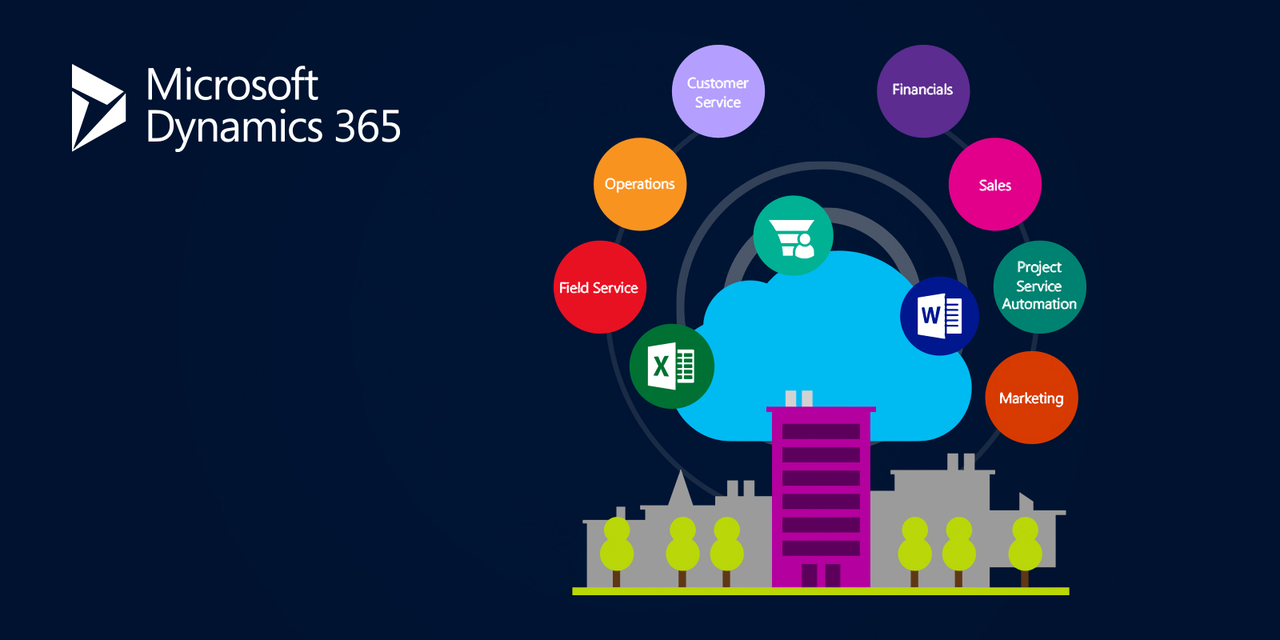What is Microsoft Dynamics 365?
Microsoft Dynamics 365 is an business-oriented application suite with a focus on enterprise resource planning and customer relationship management. Thanks to the large amount of apps it contains, Dynamics 365 can assist pretty much any business, be it a mom-and-pop store or an international corporation. Applications contained within the suite can be divided into four categories: Sales, Service, Finance, and Supply Chain. Sales applications can be used to model customers and predict their needs, and to automate sales. Service applications are focused on improving contact centers; they include tools necessary to build self-service platforms, cross-team collaboration apps, and an AI conversation bot. Finance applications will allow your business to monitor Key Performance Indicators in real-time and improve your workers’ productivity. Finally, Supply Chain applications can reduce manufacturing downtime, monitor product inventory, and predict supply chain disruptions. All of these highly useful tools have been developed by Microsoft; as such, they are only available on the Windows operating system. But there are several workarounds that can be used to run Microsoft Dynamics 365 on Mac as well. Read the article below for instructions.
Why doesn’t Microsoft Dynamics 365 run on Mac?
There are several reasons why some apps don’t run on Mac. It could be an incompatibility with Mac hardware or macOS version. Also, macOS Catalina and Big Sur don’t support 32-bit apps. Most developers are designing new, 64-bit versions of the apps, but there are still hundreds of apps that can only run on 32-bit Macs. In our case, the reason is that Microsoft Dynamics 365 native Macintosh version simply doesn’t exist. At the present moment, there is no information about the release date and the possibility that Microsoft Dynamics 365 will be available for Mac.
How to run Microsoft Dynamics 365 on Mac
The most popular solution for running Microsoft Dynamics 365 on Mac/MacBook is virtualization software. Despite the fact that emulators usually demand quite a lot of computing power out of a Mac, some of them, for example, Parallels, VirtualBox, or VMWare, can be used to run different programs on OS X with minimal losses in performance. Moreover, some of them are compatible with DirectX 11, which can help with running graphically demanding apps and games. They also allow you to copy any files between your Windows installation and OS X freely.
Running Microsoft Dynamics 365 through Parallels

Parallels Desktop is easily the best virtualization program available on Mac; as such, it is the best way to run Microsoft Dynamics 365 on Mac. It allows you to install Windows 10 on Mac with just a couple of clicks and switch between OS X and Windows instantly. So you will be able to run Windows and install Microsoft Dynamics 365 just like on a regular PC.
Running Microsoft Dynamics 365 through other virtual machines
Another popular virtualization program is VMware Fusion. It is a software hypervisor that allows running virtual machines like guest operating systems, such as Windows, Linux, FreeBSD, and Solaris. Fusion’s current versions provide hardware-accelerated DirectX 11 and OpenGL 4.1 capabilities to virtual machines, which allows them to run heavy, GPU-intensive applications and games with top 3D graphics.
You can also try VirtualBox, Wine, and QEMU, however, these solutions are not user-oriented and may require advanced computer skills.
Running Microsoft Dynamics 365 on remote server
If you have a powerful Windows-based server and a fast internet connection, another method is Microsoft Dynamics 365 running on Windows on a Server machine (in the cloud, or remote desktop) and looking at the screen from your Mac.
You can use TeamViewer, AnyDesk, or other software for this purpose.
Running Microsoft Dynamics 365 on Windows 10 using Boot Camp
Note: Mac M1 chipsets are not supported by BootCamp
BootCamp allows users to choose the system to work in on startup, however, you won’t be able to switch between systems like in Parallels. Do note that you will need no less than 64 GB of free space on your device (we recommend having 128 GB). After Windows installation completes, your Mac starts up in Windows and opens a ”Welcome to the Boot Camp installer” Window. You will need to reboot your machine every time you want to switch from Mac to Windows and vice versa. To set up Windows via BootCamp, please, do the following:
For OS X El Capitan 10.11 and older
Important: for MacOS versions prior to OS X El Capitan 10.11 you will need to create bootable Windows USB.
- Download Windows ISO file
- Open Boot Camp Assistant (Go to Applications > Utilities)
- Define the Windows partition size choose downloaded Windows ISO file
- Format Windows partition and go through all Windows installation steps
- When Windows boots for the first time follow on-screen instructions to install Boot Camp and Windows support software (drivers)






